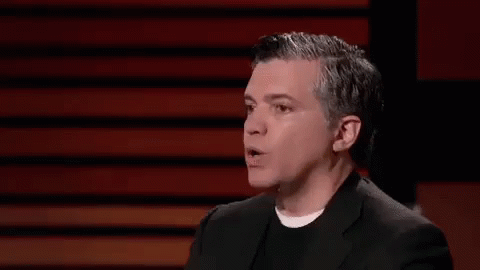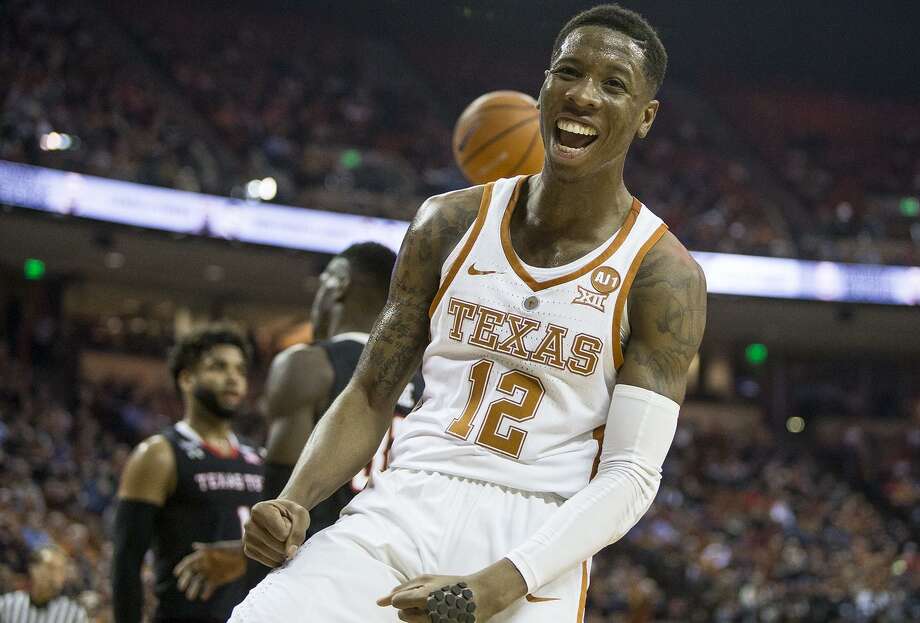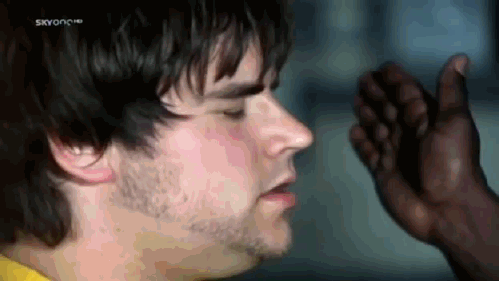Well, let's talk about the Garrett Wilson situation.
With his commitment to Ohio State on Sunday evening, a wide receiver prospect that ranks as one of the best the state of Texas has produced in the last decade is likely escaping the burnt orange clutches that reside up and down all of Lake Travis and within a 30-mile radius of it. There's no getting around the weight of the loss in this head-to-head battle, as I would contend the Longhorns don't have a player in the program quite as dynamic as Wilson projects to be at this stage of his development.
So, it stings.
That truth being established, it's also very true that the Longhorns have recruited the wide receiver position pretty damn well in the last few years and already have the most talented wide receiver unit in the Big 12 on paper, a unit that added one of the best three-man trios of any school in the country in recruiting just a few months ago.
The difference between Wilson and those other players is that the draft analytics in conjunction with recruiting suggest that if you view Wilson as a five-star level prospect as I do, he is twice as likely to become a drafted player in the NFL as anyone Texas has on the roster. Still, the state of Texas has become a 7-on-7 state, which means that receivers with NFL upside pretty much grow on trees, which means the Longhorns won't lack options in the wake of losing Wilson.
From a slightly bigger picture standpoint, it's going to be very, very hard for the Longhorns to recreate the same in-state recruiting magic as they did in the 2018 class. A year ago, six of the top eight prospects in the Lone Star State ended up signing with the Longhorns, but that number might only be two or three in 2019 based on current projections.
The situation also serves as a reminder that players of Wilson's pedigree have questions about the state of the Texas offense that haven't yet been fully answered in Tom Herman's first 17 months of the job. It's a question that will remain for the next Garrett Wilson in 2020 if the Texas offense doesn't make major strides this season.
It's as simple as that.
No. 2 - My annual NFL Draft Breakdown ...
You knew it was coming because I do this every single year, so let's not waste any time in getting right to it. I love this stuff.
A few things that need to be established.
1. There are currently 128 FBS programs playing college football in 2018, which means there are 10,9865 scholarship players in college football if every school has maxed out its 85-man scholarship limit.
2. From 2013-2015 (the three classes that almost exclusively made up the 2018 NFL Draft Class), Rivals.com rated on the average 3,972 players per year (including JUCO and prep schools), with the average star distribution breakdown looking like this:
Five stars (6.1): 34.67
Four stars (6.0): 44.67
Four stars (5.9): 85.00
Four stars (5.8): 212.67
Three stars (5.7) 286.33
Three stars (5.6) 358.67
Three stars (5.5) 599.00
Two stars (5.4) 968.33
Two stars (5.3) 716.00
Two stars (5.2) 666.33
With those numbers serving as the foundation of the average Rivals.com recruiting class numbers over a three-year window, let's break down what the numbers look like over the course of all seven rounds of the NFL Draft this year, beginning with a look at the numbers in the first round:
Five stars (6.1): 8
Four stars (6.0): 0
Four stars (5.9): 3
Four stars (5.8): 7
Three stars (5.7) 3
Three stars (5.6) 5
Three stars (5.5) 2
Two stars (5.4) 1
Two stars (5.3) 1
Two stars (5.2) 0
Unranked: 2
Here's what that translates to when you crunch the numbers:
a. 23.08-percent of five-star (6.1) prospects were drafted in the first round.
b. 0.00-percent of high-four star (6.0) prospects were drafted in the first round.
c. 3.53-percent of mid-four star (5.9) prospects were drafted in the first round.
d. 3.29-percent of low-four star (5.8) prospects were drafted in the first round.
e. 1.07-percent of high-three star (5.7) prospects were drafted in the first round.
f. 1.39-percent of mid-three star (5.6) prospects were drafted in the first round.
g. 0.33-percent of low-three star (5.5) prospects were drafted in the first round.
h. 0.01-percent of high-two star (5.4) prospects were drafted in the first round.
i. 0.14-percent of mid-two star (5.3) prospects were drafted in the first round.
j. 0.00-percent of low-two star (5.2) prospects were drafted in the first round.
The thing that just jumps out you is the incredible presence of five-stars in the first round, as nearly a fourth of all players drafted were among the top 0.87-percent of all players that are ranked in the Rivals rankings. While the five-stars didn't quite perform as well as the 2017 NFL Draft Crop (10 of the top 32 picks were former five-stars), the overall emphatic level of dominance of that position group when measured against any other tier is staggering.
Big picture translation: 23.08 percent of the first-round pie was comprised of the top 0.87-percent of all players ranked by Rivals.
Now let’s take a look at the top three rounds.
Five stars (6.1): 13
Four stars (6.0): 8
Four stars (5.9): 5
Four stars (5.8): 23
Three stars (5.7) 8
Three stars (5.6) 15
Three stars (5.5) 11
Two stars (5.4) 5
Two stars (5.3) 1
Two stars (5.2) 0
Unranked: 11
Here's what that translates to when you crunch the numbers:
a. 37.50-percent of five-star (6.1) prospects were drafted in the first three rounds.
b. 17.91-percent of high-four star (6.0) prospects were drafted in the first three rounds.
c. 5.88-percent of mid-four star (5.9) prospects were drafted in the first round.
d. 10.81-percent of low-four star (5.8) prospects were drafted in the first three rounds.
e. 2.79-percent of high-three star (5.7) prospects were drafted in the first three rounds.
f. 4.18-percent of mid-three star (5.6) prospects were drafted in the first three rounds.
g. 1.84-percent of low-three star (5.5) prospects were drafted in the first three rounds.
h. 0.52-percent of high-two star (5.4) prospects were drafted in the first three rounds.
i. 0.14-percent of mid-two star (5.3) prospects were drafted in the first three rounds.
j. 0.00-percent of low-two star (5.6) prospects were drafted in the first three rounds
Now let’s take a look at all seven rounds.
Five stars (6.1): 20
Four stars (6.0): 13
Four stars (5.9): 18
Four stars (5.8): 41
Three stars (5.7) 40
Three stars (5.6) 27
Three stars (5.5) 26
Two stars (5.4) 31
Two stars (5.3) 8
Two stars (5.2) 10
Unranked: 33
Here's what that translates to when you crunch the numbers:
a. 58.22-percent of five-star (6.1) prospects were drafted in one of the seven rounds.
b. 29.10-percent of high-four star (6.0) prospects were drafted in one of the seven rounds.
c. 21.18-percent of mid-four star (5.9) prospects were drafted in one of the seven rounds.
d. 19.28-percent of low-four star (5.8) prospects were drafted in one of the seven rounds.
e. 13.97-percent of high-three star (5.7) prospects were drafted in one of the seven rounds.
f. 7.53-percent of mid-three star (5.6) prospects were drafted in one of the seven rounds.
g. 4.34-percent of low-three star (5.5) prospects were drafted in one of the seven rounds.
h. 3.20-percent of high-two star (5.4) prospects were drafted in one of the seven rounds.
i. 1.12-percent of mid-two star (5.3) prospects were drafted in one of the seven rounds.
j. 1.50-percent of low-two star (5.6) prospects were drafted in one of the seven rounds.
Added Takeaways
* As was the case in the early rounds, the five-star position as a whole regressed back to the mean of this group's annual numbers after a massive spike in the 2017 Draft (83.16-percent of all five-stars were drafted). The fact that the position as a whole posted a number that's lower than the mean from the numbers posted in this decade was probably connected to last year's massive rise of the performance numbers.
* While the production of the five-stars dipped, the performance of the middle and lower-tiers of four-star prospects improved considerably, so much so that this year's four-star class of prospects performed better as a whole than it ever has at any point in the decade.
* The high three-star ranking continues to be on a different level of performance than the middle- and low-three star rankings in the Rivals system. In a normal year, the 5.7 three-star often performs near the levels of a mid- or low-four star, but the performance of those rankings this year meant that the high three star was outperformed by near 2:1 levels at a minimum by four stars, but performed at near 2:1 levels against the other three stars.
* Perhaps the most interesting trend that continued this year is that the high majority of five-stars (65.0-percent) selected in the draft were taken in the top three rounds. While 8 five-star prospects were taken in the first round, the position averaged less than two per round in the final three rounds. Even against improved four-star numbers, a five-star was 6.5X more likely to be drafted in the first three rounds than players that rank as mere national top 250 prospects coming out of high school.
No. 3 - Talent from Texas under-performs ... again ...

The state of Texas did it again.
In what it is becoming more than a worrisome trend, the top prospects in the state of Texas continue to perform at levels far below the national norms.
Of the first 10 prospects selected in the draft from the Lone Star State, only two (Connor Williams and Malik Jefferson) were four- or five-stars in the Rivals.com rankings. One year after Myles Garrett, Jamal Adams and Soloman Thomas helped neutralize the annual trend of four- and five-star prospects from Texas developing at levels below the national averages, twice the number of three-stars from Texas were drafted in the first three rounds as four stars and five stars added together.
Even more staggering, Texas produced three of the five (Williams, Jefferson and DeShon Elliott) four- or five-star prospects that the state produced for the draft this year. Texas A&M defensive back Armani Watts and Oklahoma State receiver Marcel Ateman, both low-four star prospects, were the only other two high-level prospects that developed into drafted players.
This isn't just a burnt orange problem, it's an everyone using prospects from the state of Texas problem, since all of out-of-state programs recruiting the state, along with likes of Oklahoma, TCU, and LSU, failed to have a single high-level prospect from the state of Texas drafted over seven rounds.
Hell, everyone eligible for the Alabama roster was seemingly selected other than former five-star/part-time starter Tony Brown.
It's a scary proposition for schools that depend on recruiting "elite-level" talent from this state. Yes, that means the University of Texas, too.
No. 4 - Turning pro came at a cost for Texas players ...
Turning pro did not really work out well for the Longhorns that left early.
Connor Williams was once thought to be a first-round pick and he went in the middle of the second round.
Malik Jefferson left thinking he'd be a first- or second-round pick, but dropped into round three.
DeShon Elliott turned his all-America season into a sixth round draft slot.
Holton Hill went undrafted.
Same with Chris Warren.

Of course, the likes of Williams and Jefferson will still sign contracts that will give them some instant security with smart financial planning and making any kind of money can be better than making none ... but still ... this early departure stuff didn't quite work out for anyone, not even Michael Dickson, who was the first punter drafted, but went in the fifth round.
A case can be made that all of the drafted Longhorns landed in spots that will serve them well in trying to create a spot on the roster for themselves, but outside of Williams and Jefferson, there won't be much in the way of signing bonuses or guaranteed money for the others.
If I'm Tom Herman, the results of this year's draft will serve as an annual cautionary tale for every junior thinking of making the leap forever more.
No. 5 – Shaka needs Snoop in the worst way ...

The commitment of Courtney Ramey was a much-needed lifeline for a 2018-19 Texas Longhorns men's basketball team that has seemingly been lacking good news inside the program for about five months, but the more you look at this team, the more obvious it becomes that the return of Snoop Roach will determine so much for next year's squad.
With Matt Coleman and Roach in the line-up, you can make a case that the Longhorns would have the best returning backcourt duo in a savage Big 12. Add in the size, playmaking and defensive capabilities of Ramey and the Longhorns would have a trio of guards that could carry this team into the land of job security for its coach.
Without Roach, the Longhorns lose the juice that Roach's returning experience and talent bring to the table. Suddenly, instead of having a backcourt that can forge the identity of next year's squad, you're left wondering if Texas will have enough in the tank at the guard position.
The margins can be very thin at this point, and the differences between what could await this team next season will be impacted significantly by Roach’s ultimate decision. Losing him takes value away from the addition of Ramey, while keeping him enhances it.
Who would have ever thought waiting on a decision from Roach would contain such gravity?
No. 6 – Taking a step back in Morgantown ...
A week ago, the top of the Big 12 standings was a crowded area.
Seven days later?
Not so much.
As if losing two of three to West Virginia wasn’t bad enough for the Longhorns, Oklahoma State emerged from its Bedlam series with Oklahoma with a three-game sweep. Suddenly, there’s not a pack at the top… just the Cowboys with a three-game lead over the Longhorns and a four-game lead over Texas Tech.
With a road trip to Lubbock looming, the wiggle room in the pursuit of a Big 12 regular-season championship is over. Winning out might be the only option and that seems pretty unlikely.
No. 7 - Elephant in the Room ...
Cat Osterman's final season at Texas was in 2006.
In the last 12 seasons, the Texas softball program has won only one conference championship and one CWS appearance since Osterman's departure, none since 2010 and 2013, respectively.
On a personal level, I've always been a very big fan of Texas coach Connie Clark, who was once very nice to someone I knew during my college days. My opinion of her as a person has always been very high.
Those confessions aside, the bar of success for the program has been placed much lower than those used to define success in other programs in the Texas athletic department.
No. 8 – Buy or Sell …

BUY or SELL: Texas will double its lot of drafted players from the 2018 draft (4) to the 2019 draft (8)?
(Sell) I think we'll see more than four, but not quite eight.
BUY or SELL: Whether Garrett Wilson declares for Texas or Ohio State tonight, that commitment will stick through signing day?
(Buy) I think Wilson is going where he prefers to a significant degree. Perhaps Texas gave him a pause, but however long the pause lasted, he was ready to commit in about 100 hours following the official visit last week. Also, I'm not sure that the industry quite has a handle of what these earlier official visits will mean in conjunction with an early signing period, but it can't be helpful for the Longhorns.
BUY or SELL: There's more to the Holton Hill story than we know. No way he went undrafted strictly because of marijuana?
(Buy) It's not just weed, it's likely the volume of times he crossed into dangerous eligibility areas because of marijuana.
BUY or SELL: Herman needs to start pushing for some commitments because in the world of momentum, Texas is falling way behind?
(Sell) I wouldn't say Texas is falling way behind in momentum. It's more of a case of losing a pair of monster recruiting battles than simply losing all momentum, as evidenced by the out of state prospects that were in town this weekend and where the Longhorns project with a few of them.
BUY or SELL: Eight regular season wins in 2018 does not garner a top-10 recruiting class for CTH and the Longhorns.
(Buy) I'm not sure how much the results of this season, good or bad, will impact the 2019 class. A big season on the field would likely impact the 2020 class much more significantly than the 2019 class.
BUY or SELL: Kerwin Roach returns but Joe Cremo ends up elsewhere?
(Buy) It just makes some common sense.
BUY or SELL: A freshman QB starts a game for Texas in 2018?
(Buy) There's zero real evidence that suggests that Sam Ehlinger and Shane Buechele will both stay healthy for 12 games or that the QB position's problems are solved by them staying healthy for all 12 games. I'm going to say Casey Thompson starts before week nine.
BUY or SELL: At least a third of the 2019 Texas football recruiting class will be from out-of-state, however of that group, a majority of them will make up the highest rated players in the class?
(Buy) Yup, I think you've got it.
BUY or SELL: Charlie Strong’s approach to recruiting and developing players has set Texas back 10 years?
(Sell) TEN YEARS?!?!? This wasn't a serious question, was it?
BUY or SELL: Tim Beck may be a good recruiter and well-liked by many, but there's little evidence to suggest that this year's offense will be appreciably better unless Tom Herman is actually involved in play calling?
(Buy) I think Beck has limitations, as do the tools he's working with, which makes for a whole lot of limited. Perhaps the bigger question is whether Tom Herman getting more heavily involved will actually make a noticeable difference?
No. 9 – Eternal Randomness of the Spotty Sports Mind …
... I kind of thought the Cowboys had a nice draft. I'm not sure how much better this draft class will make them, but up and down the draft list are players that I think can/will serve roles moving forward. I'm not sure there's a star in the bunch, but I can definitely see each of the first five picks becoming contributors/future starters.
... On one hand, I think the Cowboys picked up a future starter in Connor Williams and on the other hand, his play from last season has me questioning just what the first part of my sentence means.
... Is Geoff Swaim about to be the starting tight end in Dallas?
... If you're DeShon Elliott and you're going to be drafted in the sixth round, at least get drafted by a team that didn't draft your competition for a roster spot in a higher round. Mission accomplished in Baltimore.
... I think Roquan Smith is going to be a multiple-time All-Pro with the Bears and possibly the best player selected in the top 10.
... Sony Michel is going to be a fantasy star in 2018 with the Patriots at some point. Same with Ronald Jones and the Buccs.
... I have zero confidence in Baker Mayfield succeeding in Cleveland. Wrong player, wrong team, wrong situation. I don't know how any NFL team could draft a Big 12 quarterback with the No. 1 overall pick. In the 20+ year history of the league, Vince Young is still the best pro quarterback that the league has ever produced.
... LeBron James is simply incredible. He's completely taken for granted at this point.
... My favorite thing about the Houston Rockets making a deep run in the NBA Playoffs is the opportunity it will create for P.J. Tucker to show the world just how valuable of a player he really is.
... Damn, Golden State looked good on Saturday night.
... Of course, Jose Mourino beat Arsene Wenger on a Marouane Fellaini goal in the 91st minute on Sunday. Of course, that happened.
No. 10 – And Finally …
Happy 85th birthday to the Red Headed Stranger. As long as we have Willie, it feels like we have a lot of what we all need. Not everything, but a lot.
Last edited:



